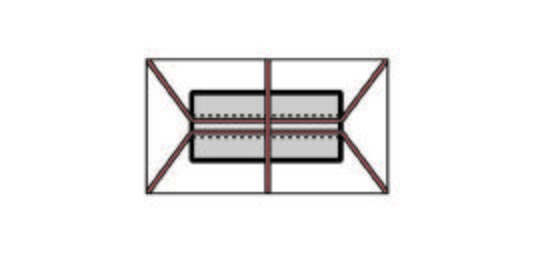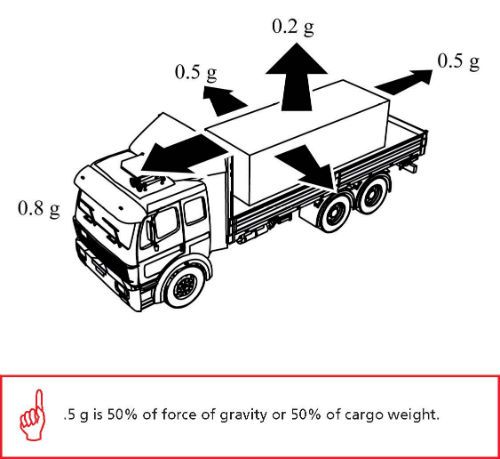CDL Practice Tests: New York State Coil Endorsement
Choose A Section:
Go!It is accepted that friction mats provide a resistance to horizontal movement equal to:
- 20% of cargo weight.
- 100% of cargo weight.
- 10,000 lbs.
- 50% of cargo weight.
Note: Friction mats provide a resistance to horizontal movement equal to 50% of the cargo weight that is resting on the mat.
Option #3 for a single metal coil with eyes lengthwise requires:
- Two indirect tiedowns over the front and rear parts of the coil.
- One direct tiedown on each diagonal through the eye of the coil
- At least one indirect tiedown side-to-side over the top of the coil.
- Two direct tiedowns on either side straight through the eye.
Securement Option #2:

Same as Option #1, except the direct tiedowns are straight instead of diagonal.
A securement system must be capable of resisting how much lateral (side-to-side) force, at minimum?
- 100% of the cargo weight
- 50% of the cargo weight
- 20% of the cargo weight
- 80% of the cargo weight
- The forward force (80% of the cargo weight) represents braking while driving straight ahead.
- The rearward force (50% of the cargo weight) represents vehicle acceleration or braking in reverse.
- The side-to-side or lateral force (50% of the cargo weight) represents traveling on a curve, ramp or changing lanes.
- The vertical force (20% of the cargo weight)) represents cargo vibration during transport. This requirement is satisfied when the cargo is "Fully Contained"
A vertical barrier across the front of the deck of a vehicle to prevent forward movement of cargo is a:
- Headboard.
- Deck.
- Rub rail.
- Cab shield.
Headboard:
A vertical barrier across the front of the deck of a vehicle to prevent forward movement of cargo.
By definition, what is a wedge?
- A tapered piece of material, thick at one end and thin at the other, used to help keep cargo from moving.
- A vertical barrier across a vehicle to prevent forward movement of cargo.
- A structure, device, or another substantial article placed against an article to prevent it from tipping that may also prevent it from shifting.
- A short piece of material, usually wood, nailed to the deck to reinforce blocking.
Wedge:
A tapered piece of material, thick at one end and thin at the other, used to help keep cargo from moving.
How many tiedowns are required for cargo that is prevented from forward movement?
- 2 every 10ft, or part thereof.
- It depends on the weight.
- 1 every 10ft, or part thereof.
- 2
When cargo is prevented from forward movement (for example, by the headboard, bulkhead, other cargo, or tiedown), secure the cargo according to the following requirements:

All Cargo:
1 tiedown for every 10 ft, or part thereof.
A stake pocket is:
- A structure, device, or another substantial article placed against an article to prevent it from tipping that may also prevent it from shifting.
- A rail along the side of a vehicle that protects the side of the vehicle from impacts.
- A female housing fixed to the side or ends of a vehicle to receive a stake or peg, and may also be used as an anchor point.
- An inflatable bag intended to fill otherwise empty space between articles of cargo, or between articles of cargo and the wall of the vehicle.
Stake Pocket:
A female housing fixed to the side or ends of a vehicle to receive a stake or peg, and may also be used as an anchor point.
A tiedown with a marked WLL of 8,000 lbs directly attached to an article has an actual WLL of:
- 4,500 lbs.
- 4,000 lbs.
- 8,000 lbs.
- 10,000 lbs.
The manufacturer’s working load limit is reduced by 50% for tiedowns which are directly attached from the vehicle to the article, and tiedowns attached to the vehicle that go around, through or over the article and are reattached to the same side of the vehicle.
When securing a metal coil with eyes lengthwise, all of the following are steps for securement option #1 except for:
- Attach at least one tiedown through the eye diagonally each way.
- Support the coil above the deck.
- These are all part of method #1.
- Attach at least one indirect tiedown side-to-side over the top.
Step #1: Support the coil above the deck to prevent the coil from rolling.
Step #2: Attach at least one direct tiedown on each diagonal through the eye of the coil making an angle not more than 45 degrees with the floor of the vehicle when viewed from the side.
Attach at least one indirect tiedown side-to-side over the top of the coil.
Use blocking or friction mats to prevent forward movement.
When should a driver inspect the cargo and securing devices?
- All of these are correct
- Within first 50 miles.
- When duty status of driver changes.
- At 3 hr intervals or 150 miles.
Inspection Requirements
The driver is responsible for the following cargo securement inspection activities:
-
Inspect Cargo and Securing devices:
- Pre-Trip: Yes
- Within first 50 mi: Yes
- When duty status of driver changes: Yes
- At 3 hour intervals or every 150 mi, whichever is first: Yes
About The New York State Coil Exam
You must have a New York State coil endorsement if you want to haul metal coils in New York.
Performance Criteria for Securement Systems:
Part I: Cargo Securement Performance Criteria
The standard provides the minimum amount of force that cargo should be expected to withstand, in each direction, as shown below.
These minimum force requirements, called the “performance criteria”, were determined after extensive testing. The securement system MUST be capable of resisting these forces, as shown below.
- The forward force (80% of the cargo weight) represents braking while driving straight ahead.
- The rearward force (50% of the cargo weight) represents vehicle acceleration or braking in reverse.
- The side-to-side or lateral force (50% of the cargo weight) represents traveling on a curve, ramp or changing lanes.
- The vertical force (20% of the cargo weight)) represents cargo vibration during transport. This requirement is satisfied when the cargo is "Fully Contained"

The performance criteria may also be expressed in terms of acceleration, which is shown at right (“g” is the term used for gravity, and represents acceleration or deceleration).
- 0.8 g deceleration in the forward direction.
- 0.5 g deceleration in the rearward direction.
- 0.5 g acceleration in a side-to-side or lateral direction.
- 0.2 g vertical acceleration.
EXAMPLE: If a steel coil weighs 10,000 lbs., the load securement must provide 8,000 lbs. of securement to prevent movement in the forward direction, which is expressed as 80% of the cargo weight (or 0.8 g).
PART II - Performance Criteria for Components of a Securement System
Each component of the cargo securement system should not exceed its Working Load Limit (WLL), when at maximum force. The Working Load Limit is the maximum load that may be applied to a component of a cargo securement system during normal service; it is usually assigned by the manufacturer of the component.
Each force in the performance criteria is to be applied separately to the securement system to determine if it is compliant.
 Cargo Securement Terms That Truck Drivers Should Know:
Cargo Securement Terms That Truck Drivers Should Know:
-
Working Load Limit (WLL):
The maximum load that may be applied to a component of a cargo securement system during normal service, usually assigned by the manufacturer of the component.
-
g:
The acceleration due to gravity, 9.823 m/sec2 (32.2 ft/sec2). For cargo securement purposes it is expressed as a percentage of cargo weight, i.e. .5g is 50% of force of gravity or 50% of cargo weight.
-
Contained:
Cargo is contained if it fills a sided vehicle, and every article is in contact with or sufficiently close to a wall or other articles so that it cannot shift or tip if those other articles are also unable to shift or tip.
-
Tiedown:
A combination of securing devices which form an assembly that attaches cargo to, or restrains cargo on, a vehicle or trailer, and is attached to anchor point(s).
Vehicle Structure and Anchor Points
The vehicle must be strong enough to resist the forces in the performance criteria (Section 1). The vehicle must be appropriate for the cargo it is to transport, or it must be adapted to be suitable by using fittings, fixtures, dunnage, cribbing or other means.
Cargo Securement Responsibility
According to federal and state regulations, the carrier and driver are responsible for ensuring that the vehicles, anchor points and other securement components are in good working order, with no obvious signs of damage. The driver is also required to conduct a pre-trip inspection by other operating regulations.
Roadside inspections are conducted in accordance with federal, state and provincial laws. If securement equipment fails inspection, it is likely that the vehicle may be placed out-of-service, and the motor carrier and/or the driver may be fined.
Questions you should be able to answer:
- What is the definition of working load limit?
- What do they call a waterproof sheet used to cover cargo?
- What is a cab shield?
- Whenever possible, a row of metal coils with eyes vertical requires one direct tiedown to secure against rearward movement at what minimum angle?
- What is the minimum angle that indirect tiedowns must form with the vehicle?
- What does "fully contained" means?
- What is blocking used for?
- What is an anchor point?
- What is a friction mat used for?
- Indirect tiedowns create what direction of force?
- How many tiedowns are required for cargo that is prevented from forward movement?
- What is the minimum number of tiedowns required through the eye of a metal coil loaded crosswise?
- What is a bulkhead used for?
- By definition, what is a wedge?
- What is aggregate working load limit?
- What is the maximum ideal angle for an effective direct tiedown?
- In cargo securement, what is bracing?
- What is a rub rail?
- A row of metal coils loaded with eyes lengthwise requires how many direct tiedowns over each side-by-side row or coil?







 TT On Facebook
TT On Facebook